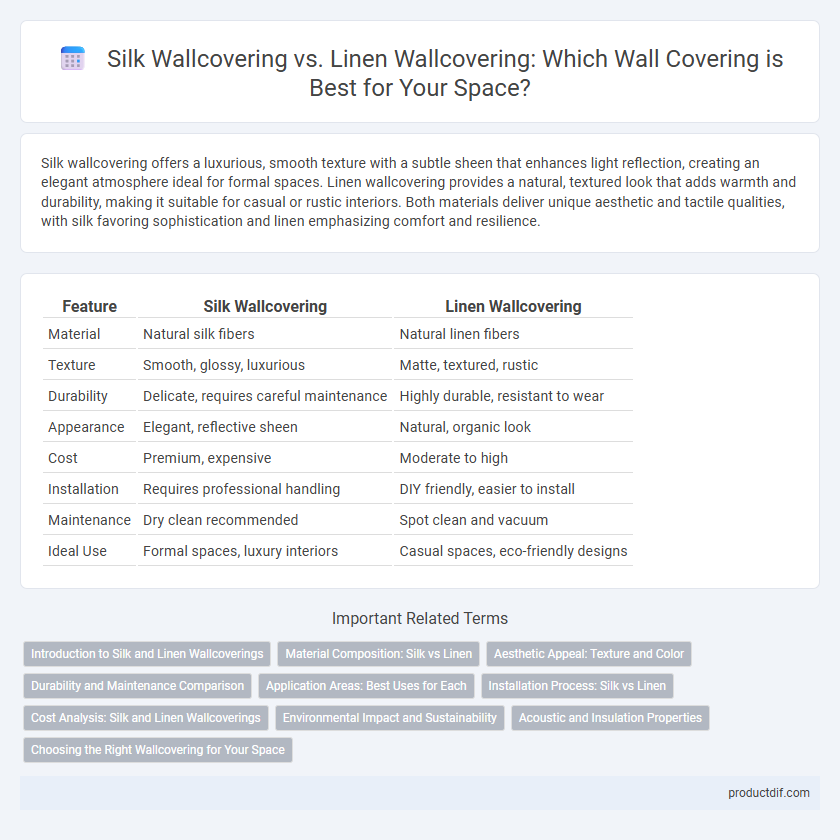Silk wallcovering offers a luxurious, smooth texture with a subtle sheen that enhances light reflection, creating an elegant atmosphere ideal for formal spaces. Linen wallcovering provides a natural, textured look that adds warmth and durability, making it suitable for casual or rustic interiors. Both materials deliver unique aesthetic and tactile qualities, with silk favoring sophistication and linen emphasizing comfort and resilience.
Table of Comparison
| Feature | Silk Wallcovering | Linen Wallcovering |
|---|---|---|
| Material | Natural silk fibers | Natural linen fibers |
| Texture | Smooth, glossy, luxurious | Matte, textured, rustic |
| Durability | Delicate, requires careful maintenance | Highly durable, resistant to wear |
| Appearance | Elegant, reflective sheen | Natural, organic look |
| Cost | Premium, expensive | Moderate to high |
| Installation | Requires professional handling | DIY friendly, easier to install |
| Maintenance | Dry clean recommended | Spot clean and vacuum |
| Ideal Use | Formal spaces, luxury interiors | Casual spaces, eco-friendly designs |
Introduction to Silk and Linen Wallcoverings
Silk wallcoverings offer a luxurious, smooth texture with a natural sheen that enhances interior elegance, making them ideal for high-end residential and commercial spaces. Linen wallcoverings provide a more casual, textured appearance with durability and breathability, suited for both contemporary and rustic design schemes. Both materials are natural fibers, but silk emphasizes opulence while linen highlights versatility and understated sophistication.
Material Composition: Silk vs Linen
Silk wallcoverings are crafted from natural protein fibers derived from silkworm cocoons, offering a smooth, lustrous texture with a luxurious sheen. Linen wallcoverings, made from flax plant fibers, provide a coarse yet elegant finish known for durability and natural breathability. The choice between silk and linen materials affects the wallcovering's appearance, texture, and maintenance, with silk delivering a refined, delicate surface and linen presenting a more rustic, textured aesthetic.
Aesthetic Appeal: Texture and Color
Silk wallcovering offers a luxurious, smooth texture with a natural sheen that enhances color vibrancy and creates an elegant, luminous ambiance in any space. Linen wallcovering provides a more tactile, matte texture with subtle irregularities, giving rooms a warm, organic feel and a softer, muted color palette. Both materials add distinct aesthetic appeal, with silk emphasizing sophistication and linen highlighting natural beauty.
Durability and Maintenance Comparison
Silk wallcoverings offer luxurious texture and vibrant sheen but require delicate care and are less durable, prone to fading and staining in high-traffic areas. Linen wallcoverings provide superior durability and easier maintenance, resisting wear with natural fibers that hold up well against moisture and frequent cleaning. Choosing linen is ideal for longevity and practical upkeep, while silk suits low-traffic spaces prioritizing aesthetic appeal.
Application Areas: Best Uses for Each
Silk wallcovering is ideal for luxurious spaces such as living rooms, bedrooms, and upscale hotels due to its elegant sheen and smooth texture that enhance formal environments. Linen wallcovering suits high-traffic areas like dining rooms, hallways, and offices, offering durability and a natural, textured look that complements casual and rustic decor. Both materials provide unique aesthetic benefits, with silk lending sophistication and linen ensuring practicality in varied interior applications.
Installation Process: Silk vs Linen
Silk wallcoverings demand a meticulous installation process due to their delicate fibers, requiring careful handling and specialized adhesives to prevent damage and ensure a smooth finish. Linen wallcoverings offer more durability and flexibility during installation, allowing for easier trimming and alignment on various wall surfaces. Both materials benefit from professional installation to achieve optimal adhesion and longevity, but silk's sensitivity often extends installation time and complexity.
Cost Analysis: Silk and Linen Wallcoverings
Silk wallcoverings generally have a higher price point due to the labor-intensive production and luxurious appearance, often ranging from $100 to $300 per roll. Linen wallcoverings tend to be more affordable, with prices typically between $50 and $150 per roll, offering a durable yet elegant alternative. When considering cost-effectiveness, linen provides a balance of quality and price, while silk represents a premium investment for sophisticated decor.
Environmental Impact and Sustainability
Silk wallcoverings, derived from natural protein fibers produced by silkworms, are biodegradable but involve resource-intensive cultivation and processing, impacting energy and water consumption. Linen wallcoverings, made from flax fibers, offer greater sustainability due to flax's low pesticide use, minimal water requirements, and full biodegradability, supporting eco-friendly production. Choosing linen over silk reduces environmental footprint by prioritizing renewable materials with lower carbon emissions and waste generation.
Acoustic and Insulation Properties
Silk wallcovering offers superior acoustic absorption thanks to its dense, smooth fibers that reduce sound reverberation and enhance room acoustics. Linen wallcovering provides excellent thermal insulation due to its natural fiber structure, which traps air and regulates indoor temperature effectively. Both materials contribute to improved environmental comfort, with silk excelling in sound dampening and linen improving thermal performance.
Choosing the Right Wallcovering for Your Space
Silk wallcoverings offer a luxurious sheen and smooth texture that enhances formal spaces, reflecting light to create an elegant ambiance ideal for living rooms or dining areas. Linen wallcoverings provide a natural, textured appearance with high durability and breathability, making them perfect for casual or high-traffic spaces like bedrooms or hallways. Selecting between silk and linen wallcoverings depends on the desired aesthetic, room usage, and maintenance requirements to ensure the wall treatment complements the space's function and style.
Silk Wallcovering vs Linen Wallcovering Infographic

 productdif.com
productdif.com